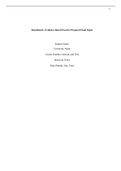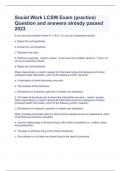1
Benchmark -Evidence Based Practice Proposal Final Paper
Student Name
University Name
Course Number, Section, and Title
Instructor Name
Date (Month, Day, Year)
, 2
Abstract
Knowing an organization's culture is very important to start the process of assessing its readiness
for Evidence Based Practice (EBP) EBP will improve the care of patients with diabetes disease,
by decreasing the length of stay during hospitalization. For the EBP to be successfully
implemented, several technological equipment including EHRs are required. Providing evidence-
based mentoring education should be provided at the organization by nurses who have adequate
experience with implementing EBP.
Diabetes is a group of related diseases that affect the endocrine system. There are more risks of
diabetes (77%) higher among African Americans compared to non-Hispanic white American in
United States. Current standards of care for diabetes disease are pharmacological treatment at
home or healthcare setting. Other non-pharmacological treatment, like physical exercises and
diet modifications, should be evaluated.
Diabetes is a life-style condition and is more prevalent among individuals of African American
ethnicity. Effectively reducing the prevalence of diabetes disease, will require strong
collaboration between healthcare providers, the healthcare system, and the community.
Achieving this goal would require adequate funding the healthcare facilities in areas occupied by
people of lower socioeconomic status. The outcomes of the project will result in tremendous
impacts on the quality care improvement.
The theoretical framework that was selected for this project is the Roger's Diffusion of
Innovation Theory. This framework is important in guiding the adoption of EBP project for
change. The stages in Roger's diffusion theory included: knowledge, persuasion, decision,
implementation, and confirmation. Diet modification is hard to achieve overnight, but success
can be visible through behavioral changes one at a time.
This EBP project is proposed to take place at an out-patient diabetes community hospital in the
Dorchester area at Carney Hospital, Boston Massachusetts. The participants targeted for this
project will be those patients with type 2 diabetes aged 18 and older with diabetes. The amount
of time needed to complete this project is essential to take around four to eight months. Two
physicians, two registered nurses, and a project manager were the key partners in this initiative.
Aside from the estimated sum of Medicare patients qualifying for case management, there shall
be zero patient contact or patient details needed for this initiative. The intervention itself would
be free of charge, as well as the other target documents.
There is no question that EBP is a strategy for problem solving that can be found in both
diagnostic and management procedures. Focus groups can be very helpful if the opportunities for
one-on-one interviews are minimal or you need to replicate a certain social environment. Since
the research was completely based on evidence-based practice, it is easy to measure and evaluate
the results. There were several groups to see whether the plan works with different individuals in
order to see the validity and applicability of the research. The view of soul food as unhealthy has
led to unhealthy cooking practices and a lack of variety. Without giving up the culture, African
Americans will still eat soul food in a healthy way.
, 3
Section A: Organizational Culture and Readiness Assessment
Knowing an organization’s culture in very important to start the process of assessing its
readiness for Evidence Based Practice (EBP). Organization culture and readiness for the whole
system integration of EBP are tools that can used to assess the organization’s level of readiness.
Based on the survey at Fallon Medical Center (FMC), regarding EBP that will improve the care
of patients with diabetes disease, by decreasing the length of stay during hospitalization. With
some level of interventions in place, the organization is prepared for the change. The category
that scored high is the availability of usable technological equipment. For the EBP to be
successfully implemented, several technological equipment including EHRs are required and
these were readily available within the organization.
Another category of readiness was the availability of resources and facilities that
enhances the efficient of implementation of EBP. The organization has libraries that are of great
importance to the team in the acquisition and access of additional knowledge regarding EBP.
However, the employee’s knowledge and attitude regarding EBP project and organizational
culture, scored low points (Jones et al., 2015). Employees lacked knowledge on the usefulness of
EBP project and how such knowledge could increase employee engagement, retain talent, drive
successful transformation and positively impacting project results (Jones et al., 2015).
Project Facilitators
Some leading facilitators of EBP include the organizational leadership which promotes
staff participation in multidisciplinary team effort when formulating new organizational policies.
The leaders have an inclusive policy encourages staff involvement in decision-making. Data
collection is done through the charting system, which makes data collection on patients’ length of
stay and caregiver involvement, relatively easy. Collaboration between several departments such
as the Intensive Care Unit (ICU), and rehabilitation department is well maintained. In addition,






